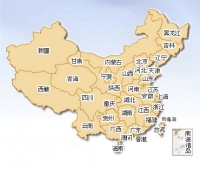| 中國 China 首都:北京 國家代碼: cn |
|
中國(漢語拼音:Zhōngguó)位於亞洲東部,傳統意義上和現代地理概念上涵蓋大中華地區。中國,又以“華夏”、“中華”、“中夏”、“諸夏”、“諸華”、“神州”等的代稱出現。“華”、“夏”二字起源不明;“夏”,在商、周以前有夏朝;“華”,有說來自於古華胥國;也有說上古華、夏同音,本一字;同“花”,鮮花盛開的地方。《左傳》是現存最早出現華夏二字並稱的文獻,其中有“裔不謀夏,夷不亂華”之言;按《說文》中的釋義,“華,榮”,“夏,中國之人”。《左傳·定公十年》疏雲:“中國有禮儀之大,故稱夏;有章服之美,謂之華。” ,《尚書正義》註“華夏”:“冕服華章曰華,大國曰夏。”;按照這裏的說法,華是指華服,夏指有禮儀的大國,而“華夏”的意思就是“身穿華服的禮儀之邦 ”。而漢語“中國”一詞,最早指天下(中國人觀念中的世界)的“中心”——中原地帶,後逐漸帶有王朝統治正統性的意義。近代以來,“中國”一詞作官方正式稱呼始於清朝。中華民國是第一個以“中國”為國號的國傢,但在中國共産黨擊敗中國國民黨並統治中國大陸後,現在一般特指中華人民共和國。
在地理上,中國的版圖由兩個不同國號的國傢即中華人民共和國和中華民國控製之領土組成,而中華人民共和國占據了大部分,故現在中國一般指中華人民共和國,而中華民國領土往往簡稱為臺灣或臺澎金馬。居於中國疆域內的各個民族統稱為中華民族,亦稱“華人”,移居境外的華人多被稱為“海外華人”,或自稱“華族”。漢族是中國人口最多,地域分佈最廣的民族。在少數民族當中,人口過500百萬(2000年人口普查)的有壯、滿、回、苗、維吾爾、彝、土傢、蒙古和藏等9大民族,通用漢語,少數民族地區往往使用各民族自己的語言。中國人普遍喜好書法、國畫、戲麯、象棋、圍棋和武術等,茶、酒、菜和筷子等為中國的特色飲食文化,中國新年、中秋、清明、端午等為傳統節日。中國傳統上是一個儒學思維國傢。中國人有強烈的家庭觀念,因此將代表家庭的姓氏置於人名之前。中國人還重視教育及對人才的選拔,春秋時期孔子“有教無類,因材施教”開始辦私塾培養人才,漢朝時采用察舉推選政府官員,隋朝起實行科舉在平民中選拔人才。自古以來在文化、科學、技術等方面的成就浩如煙海,明清以來西方的近代科技和民主政治思想傳入中國。 中國歷來重視編修歷史,歷朝歷代都設有史官,因此保存有十分詳盡的歷史資料,如《二十四史》、《資治通鑒》等。距今約4000多年前,以中原地區為中心開始出現聚落組織進而成國傢和朝代,後歷經多次演變和朝代更迭,持續時間較長的朝代有商、周、漢、唐、宋、明和清等,各朝各代也出現過太平盛世,如漢朝文景之治和光武中興、唐朝貞觀之治和開元盛世、明朝萬歷中興、清朝康乾盛世等,科學研究顯示中國朝代的更替常受氣候與糧食生産量影響,會導致處在戰亂或分裂時期。中原王朝歷史上不斷與北方遊牧民族交往、徵戰,如匈奴、突厥、鮮卑、蒙古和女真(滿族)等,其中,魏晉時代曾經有五胡亂華,而蒙古和女真甚至入主中原,改變了中國和世界的歷史發展進程,衆多民族融入中華民族的大家庭。辛亥革命後,中國的帝王國體於1912年退出歷史舞臺,取而代之的是共和國體的中華民國與中華人民共和國,中國歷史步入現代。 1949年後,由於國共內戰的結果,使得二個繼承“中國”的國名但互不隸屬的政治實體並存,中華人民共和國和中華民國均聲稱對整個中國擁有主權。中國是世界上少數最早産生文明並延續至今的國傢之一,因其文化傳播的廣泛性、獨特性和成熟性而對周邊國傢和民族的文化産生深遠影響,同時不斷吸收各個民族的文明成果而演變為今天的中華文化。 China is one of the world's oldest civilizations and is regarded as the oldest continuous civilization. For centuries, it possessed the most advanced society and economy in the world through successive dynasties though it subsequently missed the industrial revolution and began to decline. In the 19th and 20th century, imperialism, internal weakness and civil wars damaged the country and its economy and led to the overthrow of imperial rule. In 1949, when major combat ended in the Chinese Civil War, two political entities emerged having the term "China" in their names: The People's Republic of China (PRC), established in 1949, commonly known as China, has control over mainland China and the largely self-governing territories of Hong Kong (since 1997) and Macau (since 1999). The Republic of China (ROC) established in 1912 on mainland China, now commonly known as Taiwan, has control over the islands of Taiwan, Penghu, Kinmen, and Matsu. In the 1950s, change to economic policies in the Republic of China (Taiwan) transformed the island into a technology-oriented industrialized developed economy after a period of high growth rates and rapid industrialization. In mainland China, in the 1970s, reforms known as the Four Modernizations modernized the agriculture, industry, technology and defense, vastly raising living standards, and making the PRC one of the great powers. Historically, China's cultural sphere has extended across East Asia as a whole, with Chinese religion, customs, and writing systems being adopted to varying degrees by neighbors such as Japan, Korea and Vietnam. Through its history, China was the source of many major inventions. It has also one of the world's oldest written language systems. The first evidence of human presence in the region was found at the Zhoukoudian cave. It is one of the earliest known specimens of Homo erectus, now commonly known as the Peking Man, estimated to have lived from 300,000 to 780,000 years ago. |
|

![中國- 维基百科,自由的百科全书 [编辑] 中国疆域之流变
點擊圖片查看詳情](http://oson.ca/upload/images11/cache/6f666c975520e06150432755a5c6f6cb.jpg)

